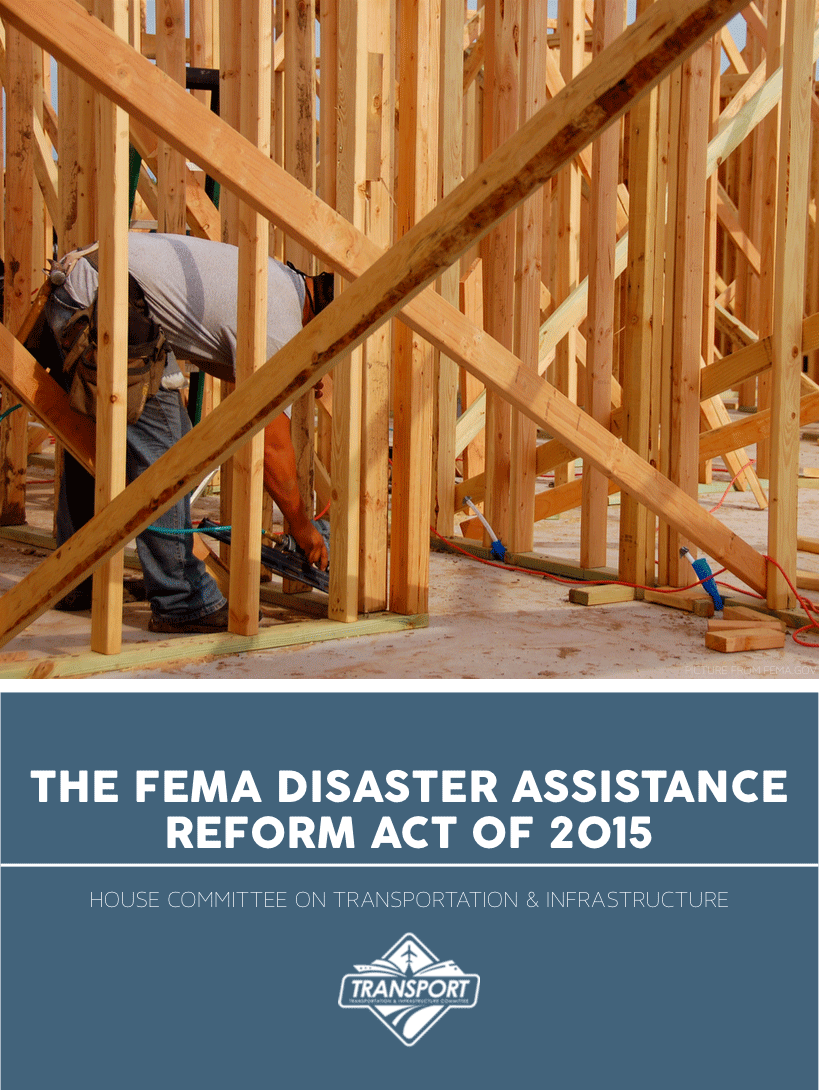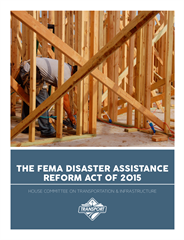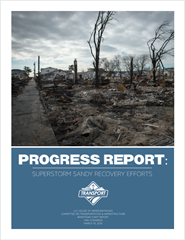Press Releases
Committee Leaders Introduce Bill to Reform Disaster Assistance Programs & Reduce Disaster CostsStaff Report on Superstorm Sandy Recovery Progress Also Released Committee leaders today introduced bipartisan legislation to address the rising costs of disasters in the United States, reduce the toll of future losses, and improve the efficiency and effectiveness of the Federal Emergency Management Agency’s (FEMA) disaster assistance capabilities and programs. The FEMA Disaster Assistance Reform Act of 2015 (H.R. 1471) was introduced in the House by Economic Development, Public Buildings, and Emergency Management Subcommittee Chairman Lou Barletta (R-PA). Transportation and Infrastructure Committee Chairman Bill Shuster (R-PA), T&I Ranking Member Peter DeFazio (D-OR), and Subcommittee Ranking Member André Carson (D-IN) are original cosponsors of the bill (click here for bill text). H.R. 1471 provides FEMA direction and authorization for key programs that help reduce the loss of life and property and speed recovery for those impacted by disaster. The bill also requires an assessment of trends in disaster losses and recommendations that will result in the reduction of losses and increased cost savings. “It’s been over 20 years since we’ve had a comprehensive look at disaster spending, and it’s time for a big picture policy review to determine why disaster spending is spiraling out of control and how we can better manage those costs for the taxpayer,” Barletta said. “I’m excited to help launch this discussion and find ways to bring costs down while ensuring we are prepared for the next big storm. This bill does exactly that and includes critical tools to make sure federal, state, and local governments are ready for any disaster.” “Disaster induced losses, both in terms of human lives and economic costs, have been increasing in recent years,” Shuster said. “The FEMA Disaster Assistance Reform Act addresses this rise in costs head-on, seeks ways to reduce losses caused by future disasters, and reforms assistance programs to make them work better for victims and impacted communities.” “This bipartisan FEMA legislation will support the first responders who protect us, it will save lives by encouraging wildfire mitigation and earthquake warning systems, and it authorizes reimbursements to state and local governments dealing with disasters,” DeFazio said. “I thank my colleagues for working in a bipartisan way, and will continue to work with them to pass this critical bill.” “The legislation we are offering today is critical to emergency response efforts,” said Carson. “As a former first responder, this bipartisan legislation will improve our Nation’s emergency management capabilities, modernize and strengthen critical components of our preparedness and response system, and support emergency response personnel. Moreover, it will allow us to gather the information necessary to control rising disaster costs.” Summary of the FEMA Disaster Assistance Reform Act of 2015 In recent years, the number of lives lost and amount of property damaged in U.S. disasters have been on the rise – as well as federal disaster assistance costs. The FEMA Disaster Assistance Reform Act of 2015 will drive an assessment of the changing costs of disasters and opportunities to reduce future losses, improve the efficiency and effectiveness of our Nation’s emergency management capabilities and federal disaster programs, modernize and strengthen critical components of our preparedness and response system, and support our emergency response personnel. The FEMA Disaster Assistance Reform Act of 2015 will:
- Authorizing FEMA through FY 2018, consistent with current funding levels; - Authorizing the Urban Search and Rescue (USAR) Response System through FY 2018, consistent with current funding levels, and clarifying liabilities and compensation issues related to participants in the system; and - Reauthorizing the Emergency Management Assistance Compacts (EMAC) Grants through FY 2018, consistent with current funding levels. The legislation also includes policy changes that result in the more efficient and effective implementation of disaster assistance programs, as well as wise investments in mitigation: Click below for more information about the FEMA Disaster Assistance Reform Act of 2015:
Progress Report: Superstorm Sandy Recovery Efforts The Committee also released a bipartisan staff report today on the progress of recovery from Superstorm Sandy and the efforts of agencies under the Committee’s jurisdiction: primarily FEMA, the U.S. Department of Transportation, and the U.S. Army Corps of Engineers. In the nearly two and a half years since Sandy, significant progress has been made in rebuilding from the storm, yet much remains to be done to fully restore impacted areas. The Committee continues to conduct its oversight of recovery efforts through regular agency briefings and updates, hearings, requests for information, and staff visits to affected areas to observe project progress firsthand. The report released today, entitled “Progress Report: Superstorm Sandy Recovery Efforts,” was prepared as part of the Committee’s oversight and is intended to be a reference to show the state of play of recovery efforts to date. Click below to read the full report:
# # # |








